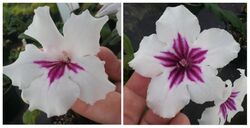| Display title | Biology:Floral symmetry |
| Default sort key | Floral symmetry |
| Page length (in bytes) | 11,621 |
| Namespace ID | 3026 |
| Namespace | Biology |
| Page ID | 838452 |
| Page content language | en - English |
| Page content model | wikitext |
| Indexing by robots | Allowed |
| Number of redirects to this page | 0 |
| Counted as a content page | Yes |
| Page image |  |
| HandWiki item ID | None |
| Edit | Allow all users (infinite) |
| Move | Allow all users (infinite) |
| Page creator | imported>Rtextdoc |
| Date of page creation | 17:37, 11 February 2024 |
| Latest editor | imported>Rtextdoc |
| Date of latest edit | 17:37, 11 February 2024 |
| Total number of edits | 1 |
| Recent number of edits (within past 90 days) | 0 |
| Recent number of distinct authors | 0 |
Description | Content |
Article description: (description)
This attribute controls the content of the description and og:description elements. | Floral symmetry describes whether, and how, a flower, in particular its perianth, can be divided into two or more identical or mirror-image parts.
Uncommonly, flowers may have no axis of symmetry at all, typically because their parts are spirally arranged. |

